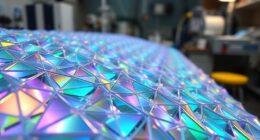Recent advances in metamaterials have brought invisibility cloaks closer to real-world use. Scientists have developed precise structures that manipulate electromagnetic waves, enabling cloaks to bend light around objects effectively. Moving from labs to street tests raises exciting possibilities across security, fashion, and privacy sectors. However, ethical concerns and technological challenges remain. Stay with us to explore how these innovations might shape future applications and societal impacts beyond the experimental stage.
Key Takeaways
- Recent metamaterial innovations enable practical invisibility cloaks suitable for real-world applications.
- Transition from laboratory prototypes to street deployment involves overcoming environmental and system integration challenges.
- Industry uses include security, surveillance, and fashion, raising privacy and ethical considerations.
- Ethical and security concerns, such as privacy invasion and misuse, necessitate regulations and safeguards.
- Future efforts focus on enhancing material durability, reducing costs, and addressing societal implications.
Breakthroughs in Metamaterial Design for Practical Use

Recent advances in metamaterial design have brought practical invisibility cloaks closer to reality. Breakthroughs in metamaterial fabrication have enabled scientists to create materials with unique properties that bend light around objects, making them less visible or invisible. These innovations involve precise structuring at microscopic levels, allowing for tailored control over electromagnetic waves. As these materials move toward real-world applications, it’s essential to contemplate invisibility ethics—how and when cloaks should be used responsibly. The progress in designing and fabricating these metamaterials demonstrates significant potential, but it also raises questions about misuse and privacy. By refining the fabrication process, researchers are overcoming previous limitations, bringing us closer to deploying invisibility cloaks beyond experimental settings and into everyday life. Incorporating vertical storage solutions and other organizational strategies can help manage the influx of new materials and devices associated with these technological advancements.
From Laboratory Experiments to Real-World Testing

Advances in metamaterial fabrication have moved beyond theoretical designs and controlled lab settings, pushing researchers to test these materials in more practical environments. As you move from controlled experiments to real-world testing, privacy concerns arise, especially regarding how invisibility devices might be used to spy or evade surveillance. Environmental impact also becomes a critical issue, since large-scale production and deployment could lead to pollution or resource depletion. You need to contemplate these factors carefully, ensuring that testing adheres to ethical standards and minimizes ecological harm. Real-world testing helps identify unforeseen challenges, like weather effects or integration with existing systems, but it also raises questions about responsible use. Balancing innovation with social responsibility is key as these cloaks begin to reach everyday settings. Additionally, considerations around beach tourism and environmental conservation are relevant since large-scale deployment could impact natural habitats and local ecosystems.
Potential Applications Transforming Industries

Metamaterial invisibility cloaks have the potential to revolutionize multiple industries by offering innovative solutions to longstanding challenges. In security and defense, they can enhance camouflage strategies, making personnel and equipment less detectable. In the fashion and retail sectors, companies might develop clothing or displays that blend seamlessly into surroundings, creating new forms of advertising or privacy. Surveillance systems could also benefit by reducing unwanted visibility, improving privacy protection. However, these advances raise privacy implications, as the technology could be exploited for clandestine monitoring or evasion. As these cloaks become more accessible, you’ll need to contemplate how their use impacts privacy rights and ethical boundaries. The development of raw food diets and other health-conscious trends exemplifies how technological progress often intersects with societal concerns about safety and authenticity. Overall, metamaterials are poised to transform how industries approach visibility, security, and personal privacy.
Ethical and Security Considerations of Invisibility Technology

How should society navigate the ethical and security challenges posed by invisibility technology? You need to consider privacy concerns, as this technology can enable secret surveillance or unauthorized spying, infringing on individuals’ rights. There’s also the risk of security breaches, where criminals could use invisibility to commit theft, vandalism, or evade detection by law enforcement. You must establish regulations that prevent misuse, ensuring transparency and accountability. Balancing innovation with ethical safeguards is key; otherwise, invisibility devices could undermine trust and safety. It’s vital to develop oversight frameworks that address these security risks while respecting privacy. Additionally, understanding cheating behaviors and their psychological impacts can help inform policies that protect individuals from exploitation or abuse related to such advanced technologies. By proactively managing these challenges, society can harness the benefits of invisibility technology without compromising security or ethical standards.
Future Perspectives and Challenges Ahead

Looking ahead, the development of invisibility technology presents both exciting opportunities and significant hurdles. You’ll need to address key challenges, including:
Advancing invisibility tech requires overcoming technological, ethical, and material challenges for real-world application.
- Technological limitations that restrict how seamlessly cloaks can operate in real-world settings.
- Privacy concerns, as widespread use could lead to unauthorized surveillance or privacy breaches.
- Material durability and cost, which impact the feasibility of mass deployment.
- Incorporating conflict resolution skills into the design process can help address ethical dilemmas and public concerns more effectively.
Overcoming these issues requires advances in materials science and ethical frameworks. While the potential for applications like security and privacy is immense, you must consider societal impacts carefully. Ensuring responsible development will be *pivotal* to balance innovation with safeguards. Only then can invisibility cloaks transition from scientific experiments to practical, safe technologies on the streets.
Frequently Asked Questions
How Durable Are These Invisibility Cloaks in Everyday Conditions?
You’re probably wondering about the durability of these invisibility cloaks in everyday life. Their fabric durability varies, depending on materials used, but many are designed for resilience. Weather resilience is essential, so researchers focus on making cloaks resistant to rain, wind, and sun exposure. While some prototypes hold up well, ongoing improvements aim to guarantee they can withstand regular wear and harsh conditions, making them practical for daily use.
What Are the Manufacturing Costs of Street-Ready Invisibility Cloaks?
You might wonder about the manufacturing costs of street-ready invisibility cloaks. A thorough cost analysis shows that these cloaks require advanced materials and precise fabrication, making initial costs high. However, as manufacturing scalability improves, costs could decrease markedly. Large-scale production could lead to more affordable prices, but current costs remain substantial due to complex technology and specialized materials, impacting widespread adoption.
How Do Invisibility Cloaks Affect the Environment During Production and Use?
You might wonder how invisibility cloaks impact the environment during production and use. They could affect resource sustainability because manufacturing requires rare materials and energy, possibly leading to pollution. During use, their environmental impact depends on durability and disposal. You should consider sustainable practices to minimize negative effects, ensuring that the development of such technology aligns with eco-friendly goals and reduces potential harm to ecosystems.
Can Invisibility Cloaks Be Integrated With Existing Security Systems?
Imagine slipping through security lines unseen, your presence hidden by advanced invisibility tech. You can integrate invisibility cloaks with existing security systems, but beware—privacy concerns and security vulnerabilities arise. While they can enhance stealth, they might also bypass cameras or alarms, risking unauthorized access. Before deploying, you need to balance the cloak’s potential with the risks, ensuring your security measures stay robust against new threats.
What Legal Regulations Govern the Use of Invisibility Technology in Public Spaces?
You should be aware that the use of invisibility technology in public spaces is mainly governed by privacy concerns and patent disputes. Laws aim to safeguard individual privacy rights, so unauthorized use could lead to legal issues. You might also face patent infringement claims if you deploy such technology without proper rights. Always stay informed about local regulations and ensure your use respects privacy laws and intellectual property rights to avoid legal trouble.
Conclusion
As metamaterials move from labs to streets, you’ll see innovation transforming industries, imagination becoming reality, and technology shaping the future. You’ll face new possibilities and challenges, ethical questions and security concerns, progress and responsibility. Embrace the journey ahead with curiosity and caution, knowing that each breakthrough brings opportunity and risk. Together, you can navigate the path of invisibility’s evolution, shaping a world where science and society walk hand in hand, towards a future of endless potential.










